Search Result
Results for "
grains
" in MedChemExpress (MCE) Product Catalog:
1
Biochemical Assay Reagents
4
Isotope-Labeled Compounds
| Cat. No. |
Product Name |
Target |
Research Areas |
Chemical Structure |
-
- HY-B1881
-
|
|
Parasite
Cholinesterase (ChE)
|
Infection
|
|
Pirimiphos-methyl is a rapid-acting organophosphorus insecticide and acaricide, causing inhibition of AChE in target organisms. Pirimiphos-methyl is often used for prevention and control of beetles, snout beetles, moths and Ephestia cautella during storage of agricultural grains .
|
-
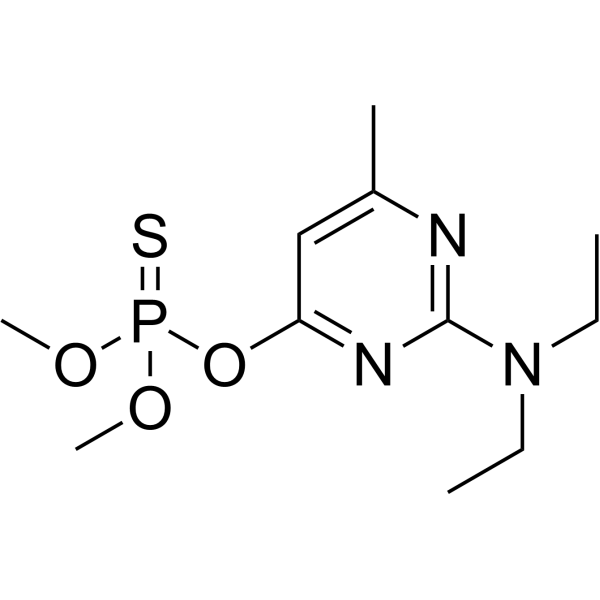
-
- HY-N4103A
-
|
|
Others
|
Cancer
|
|
Δ5-Avenasterol, belongs to the components of oat grain , exhibits propounding antioxidant effectiveness .
|
-
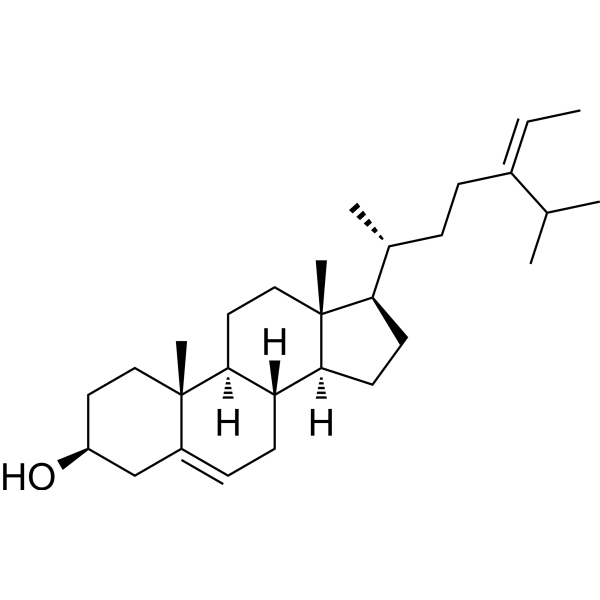
-
- HY-W167708
-
|
|
Others
|
Others
|
|
2-Ethyl-5-methylphenol is an aromatic compound that can be detected in breakfast cereals, cereals and grain products .
|
-
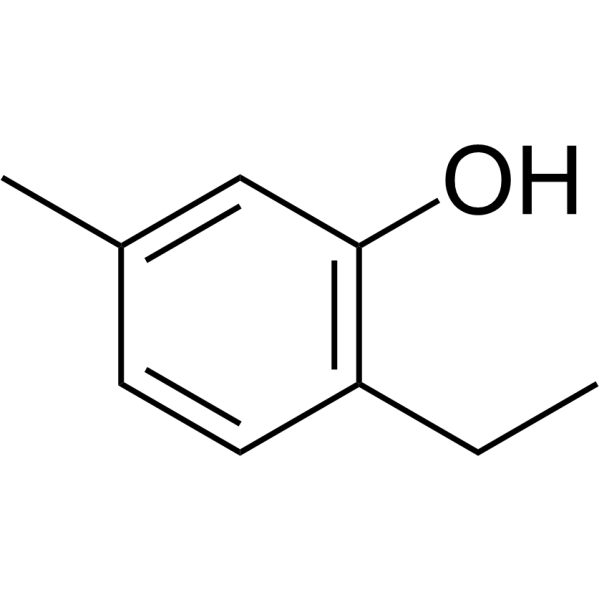
-
- HY-124741
-
|
|
Others
|
Others
|
|
Jamaicin is a natural isoflavone found in the grains of Millettia pachyloba (Leguminosae) .
|
-

-
- HY-B1881S
-
|
|
Isotope-Labeled Compounds
Parasite
Cholinesterase (ChE)
|
Infection
|
|
Pirimiphos-methyl-d6 is the deuterium labeled Pirimiphos-methyl. Pirimiphos-methyl is a rapid-acting organophosphorus insecticide and acaricide, causing inhibition of AChE in target organisms. Pirimiphos-methyl is often used for prevention and control of beetles, snout beetles, moths and Ephestia cautella during storage of agricultural grains[1][2][3].
|
-
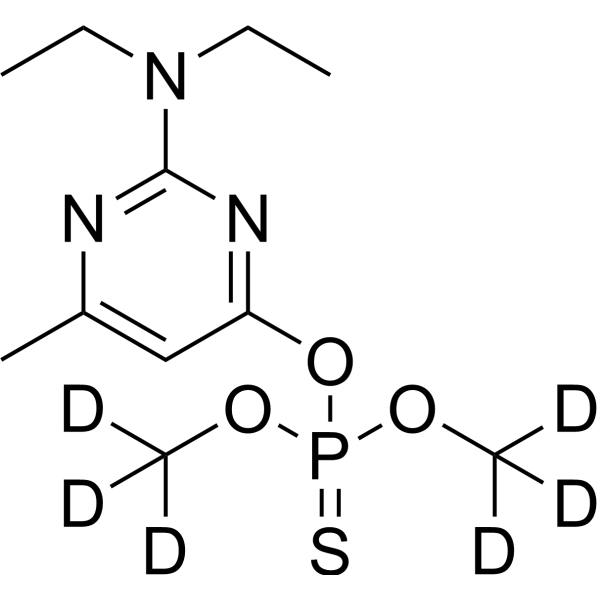
-
- HY-N3045
-
|
|
Others
|
Others
|
|
(S,S)-Pisatin (compound 8) is a dimeric pterocarpan derivative is isolated from the grains of millettia pachyloba .
|
-
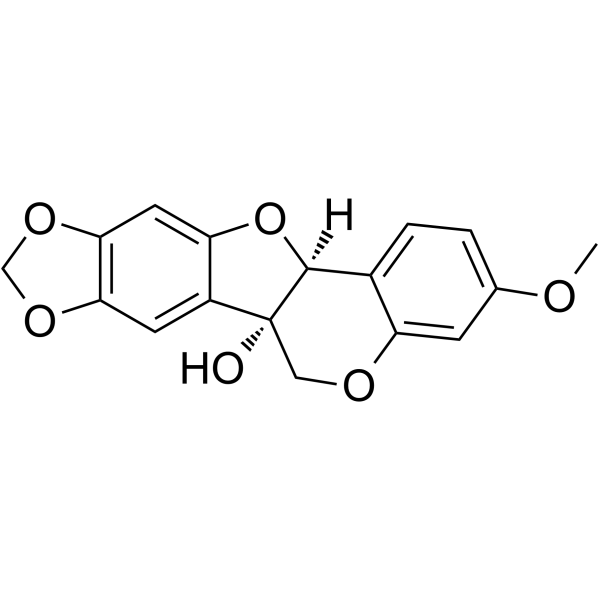
-
- HY-N1938
-
|
D-Raffinose pentahydrate
|
|
|
|
D(+)-Raffinose pentahydrate (D-Raffinose pentahydrate) is a trisaccharide composed of galactose, glucose, and fructose that occurs naturally in a variety of vegetables and grains. D(+)-Raffinose pentahydrate is a functional oligosaccharide.
|
-
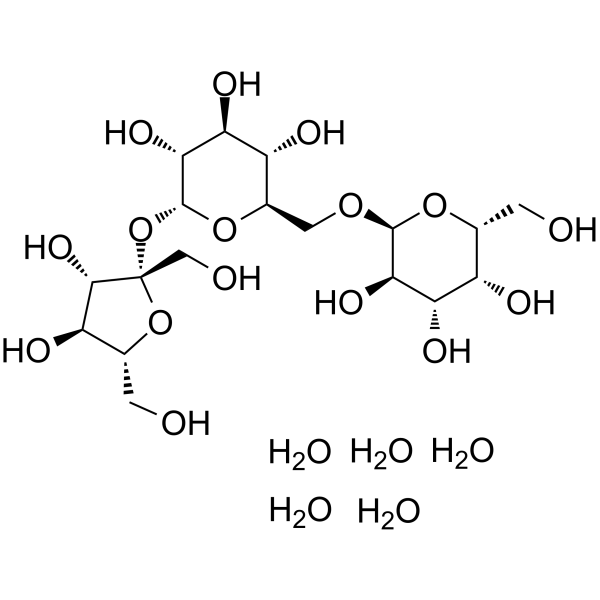
-
- HY-N6723
-
|
|
Acyltransferase
|
Infection
|
|
Fumonisin B2, a mycotoxin produced by Fusarium moniliforme in various grains, is a potent inhibitor of sphingosine N-acyltransferase (ceramide synthase) and disrupts de novo sphingolipid biosynthesis .
|
-
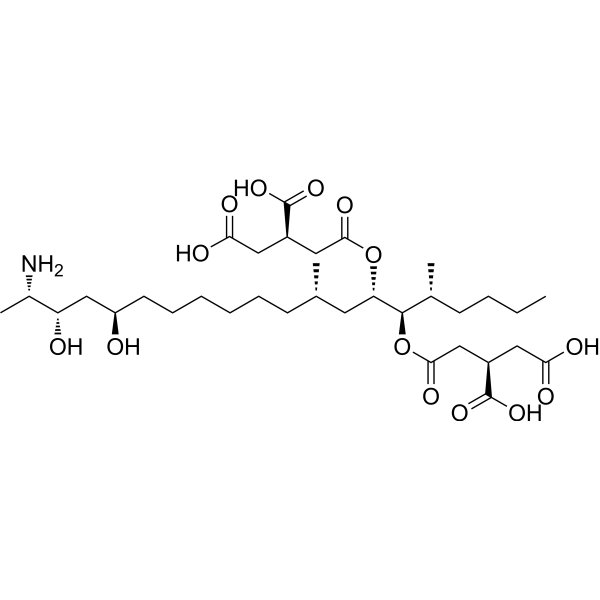
-
- HY-N5141
-
|
|
Others
|
Others
|
|
Isoscoparin-2′′O-glucoside is a flavonoid that can be found in yellow grain mutant of rice. Isoscoparin-2′′O-glucoside shows antioxidant activity .
|
-
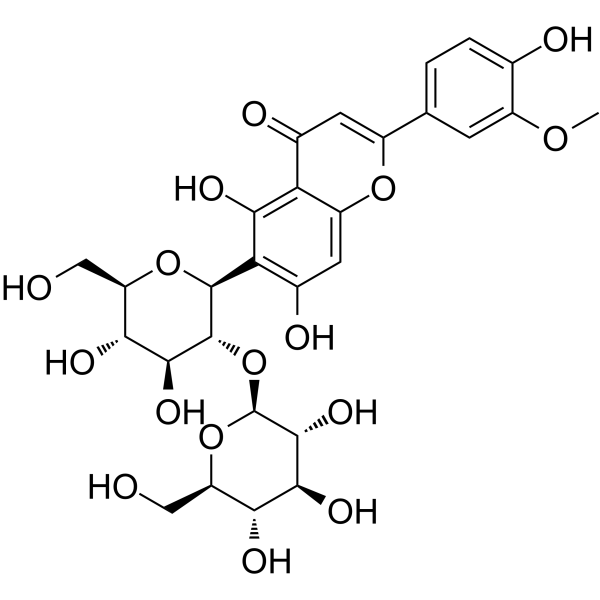
-
- HY-129459
-
|
|
Endogenous Metabolite
|
Cardiovascular Disease
Neurological Disease
|
|
α-Tocotrienol is an isoform of vitamin E and found in vegetables, fruits, seeds, nuts, grains, and oils. Vitamin E plays a role as an antioxidant, in lowering cholesterol and other lipids, as a neuroprotective and anticancer agent, and in cardiovascular disease protection.
|
-

-
- HY-108695
-
|
|
Apoptosis
Endogenous Metabolite
|
Cancer
|
|
Enterodiol is transformed by human intestinal bacteria from lignans contained in various whole-grain cereals, nuts, legumes, flaxseed, and vegetables. Enterodiol has an apoptotic effect in colorectal cancer (CRC) cells. Anti-cancer activities .
|
-

-
- HY-122778
-
|
|
Others
|
Cardiovascular Disease
Neurological Disease
Cancer
|
|
δ-Tocotrienol is a Vitamin E in vegetables, fruits, seeds, nuts, grains and oils. Vitamin E has become well known for its role as an antioxidant, in lowering cholesterol and other lipids, as a neuroprotective and anticancer agent, and in cardiovascular disease protection.
|
-

-
- HY-N6697
-
|
|
Bacterial
Antibiotic
Parasite
|
Infection
Cancer
|
|
Aflatoxin G1 is one type of aflatoxins occuring in nature. It is produced by molds, such as Aspergillus flavus and Aspergillus parasiticus. Aflatoxins are hepatogenic, teratogenic, imunosuppressive, and carcinogenic fungal metabolites found in feeds, nuts, wine-grapes, spices, and other grain crops .
|
-
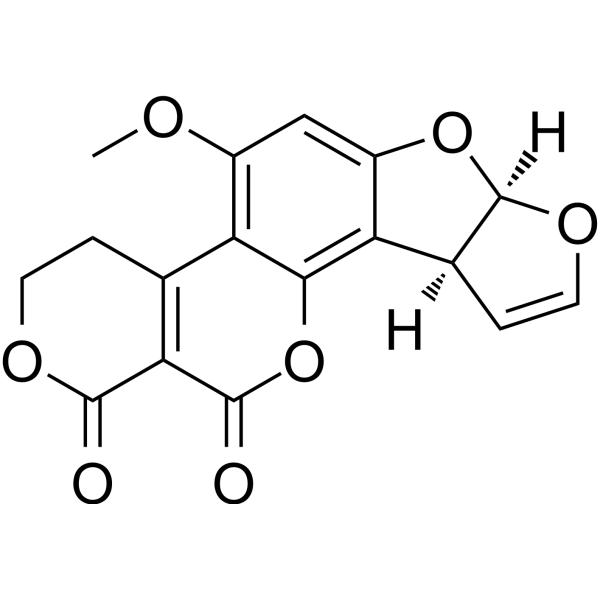
-
- HY-N12428
-
|
Caudicifolin; Fischeriana A
|
Others
|
Others
|
|
17-Hydroxyjolkinolide A (Caudicifolin; Fischeriana A) is an insect feeding inhibitor isolated from the roots of spurge. 17-Hydroxyjolkinolide A induces grain aversion in S. zeamais and T. castaneum adults, with EC50s of 631.9 ppm and 656.5 ppm, respectively.
|
-

-
- HY-108695B
-
|
|
Apoptosis
Endogenous Metabolite
|
Cancer
|
|
(±)-Enterodiol is the racemate of Enterodiol (HY-108695). Enterodiol is transformed by human intestinal bacteria from lignans contained in various whole-grain cereals, nuts, legumes, flaxseed, and vegetables. Enterodiol has an apoptotic effect in colorectal cancer (CRC) cells. Enterodiol has anti-cancer activities .
|
-
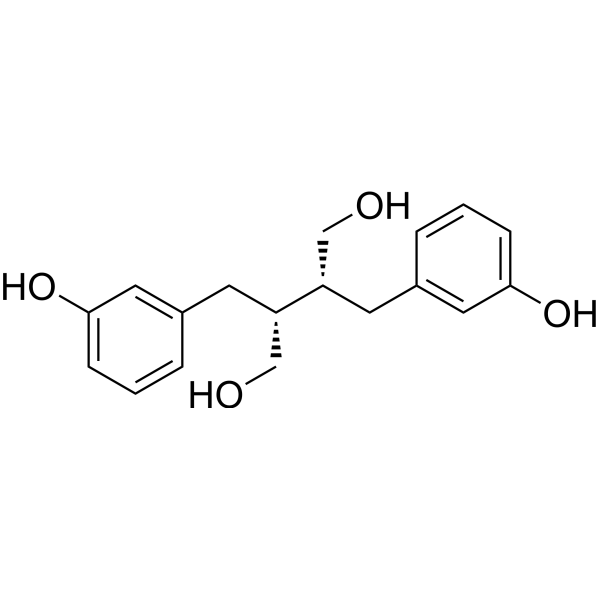
-
- HY-123037
-
|
|
Fungal
|
Infection
|
|
Triadimefon is a triazole fungicide used to control powdery mildew, rusts, and other fungal pests on grains, fruit and vegetable crops, turf, shrubs, and trees. Triadimefon inhibits lanosterol 14α-demethylase, interfering with oxidative demethylation reactions in the ergosterol biosynthesis pathway of fungi, and also blocks gibberellin biosynthesis.
|
-
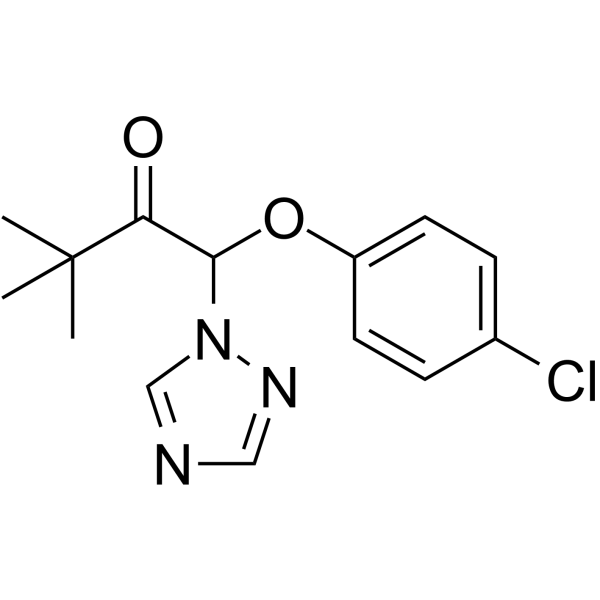
-
- HY-N6678
-
|
|
Estrogen Receptor/ERR
|
Endocrinology
|
|
Zearalenone is a nonsteroidal estrogenic mycotoxin produced by Fusarium species, which colonizes several grains. Zearalenone has low acute toxicity and carcinogenicity. Due to its agonistic effect on the estrogen receptor, Zearalenone exhibits distinct estrogenic and anabolic properties in several animal species, resulting in severe effects on the reproductive system .
|
-
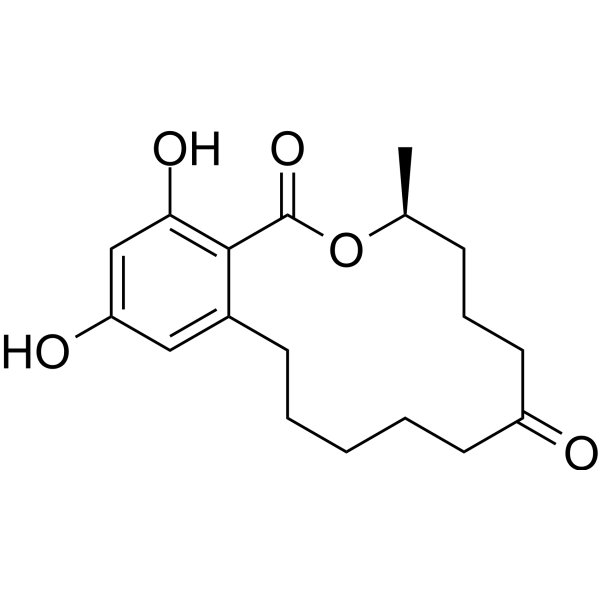
-
- HY-N0814B
-
|
Inositol hexaphosphate hexasodium; SNF472
|
Endogenous Metabolite
|
Neurological Disease
Inflammation/Immunology
|
|
Phytic acid (Inositol hexaphosphate) hexasodium is a phosphorus storage compound of seeds and cereal grains. Phytic acid hexasodium has a strong ability to chelate multivalent metal ions, specially zinc, calcium, iron and as with protein residue. Phytic acid hexasodium inhibits the enzymatic superoxide source xanthine oxidase (XO), and has antioxidative, neuroprotective, anti-inflammatory effects.
|
-
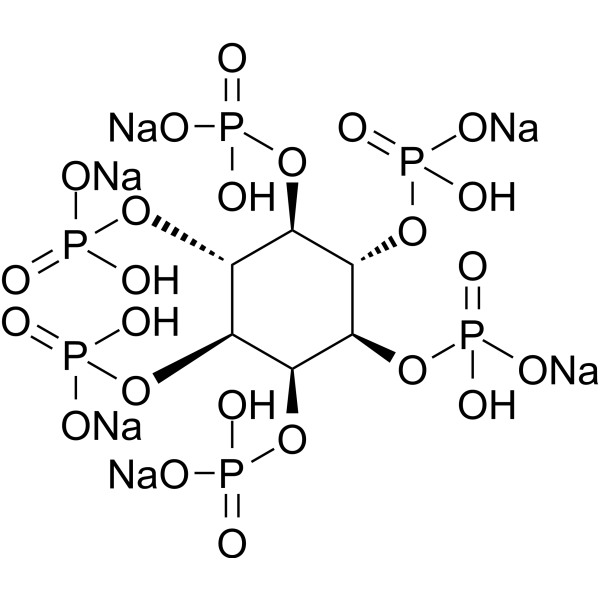
-
- HY-N6723S
-
|
|
Isotope-Labeled Compounds
|
Infection
|
|
Fumonisin B2- 13C34 is the 13C labeled Fumonisin B2 (HY-N6723) . Fumonisin B2, a mycotoxin produced by Fusarium moniliforme in various grains, is a potent inhibitor of sphingosine N-acyltransferase (ceramide synthase) and disrupts de novo sphingolipid biosynthesis .
|
-
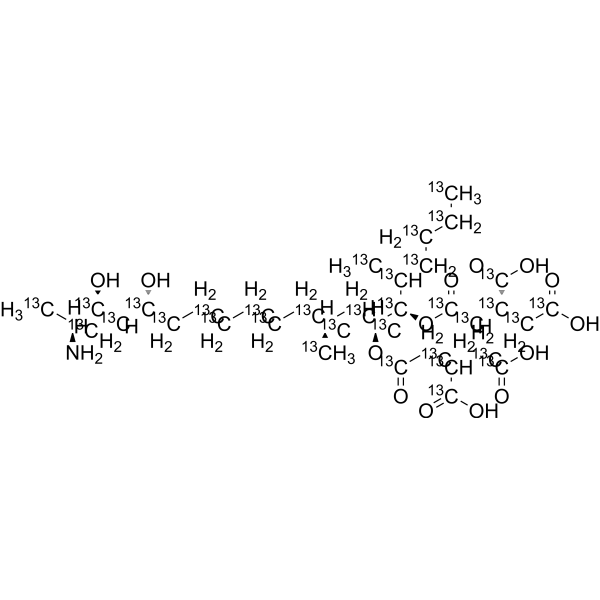
-
- HY-N0814
-
|
Inositol hexaphosphate; SNF472 free acid
|
Xanthine Oxidase
Endogenous Metabolite
|
Neurological Disease
Inflammation/Immunology
|
|
Phytic acid (Inositol hexaphosphate) is a phosphorus storage compound of seeds and cereal grains. Phytic acid is known as a food inhibitor, which has a strong ability to chelate multivalent metal ions, specially zinc, calcium, iron and as with protein residue. Phytic acid inhibits the enzymatic superoxide source xanthine oxidase (XO), and has antioxidative, neuroprotective, anti-inflammatory effects .
|
-
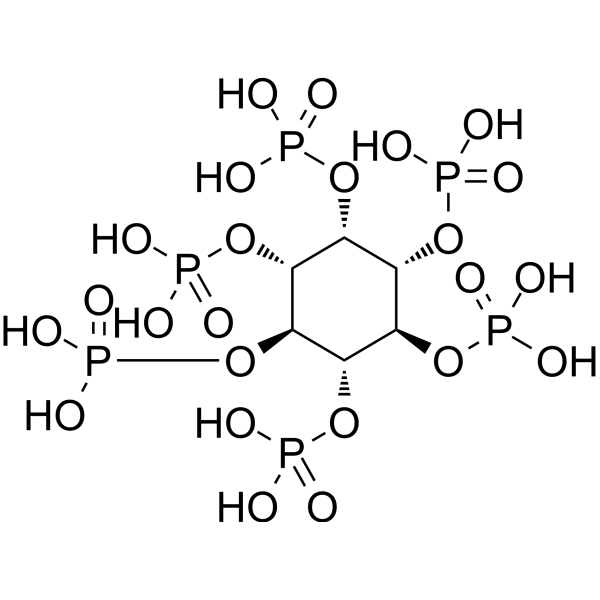
-
- HY-N0814A
-
|
Inositol hexaphosphate dodecasodium hydrate; SNF472 dodecasodium hydrate
|
Xanthine Oxidase
Endogenous Metabolite
|
Neurological Disease
Inflammation/Immunology
|
|
Phytic acid (Inositol hexaphosphate) dodecasodium hydrate is a phosphorus storage compound of seeds and cereal grains. Phytic acid dodecasodium hydrate is known as a food inhibitor, which has a strong ability to chelate multivalent metal ions, specially zinc, calcium, iron and as with protein residue. Phytic acid dodecasodium hydrate inhibits the enzymatic superoxide source xanthine oxidase (XO), and has antioxidative, neuroprotective, anti-inflammatory effects .
|
-
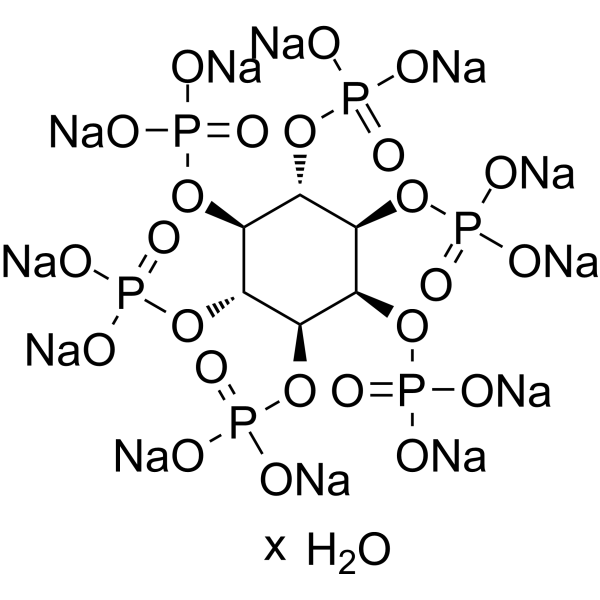
-
- HY-E70013
-
|
endo-1,3:1,4-β-D-Glucanase
|
Endogenous Metabolite
|
Metabolic Disease
|
|
Lichenase, Microorganism (endo-1,3:1,4-β-D-Glucanase) is a specific, endo-(1-3),(1-4)-β-D-glucan 4-glucanohydrolase. Lichenase, Microorganism solubilizes β-glucans from cereal grains and gives gluco-oligosaccharides (GOS). Lichenase, Microorganism can be used in the degradation of polysaccharides in the cell walls .
|
-

-
- HY-N6697S
-
|
|
Isotope-Labeled Compounds
|
Cancer
|
|
Aflatoxin G1- 13C17 is the 13C labeled Aflatoxin G1 (HY-N6697) . Aflatoxin G1 is one type of aflatoxins occuring in nature. It is produced by molds, such as Aspergillus flavus and Aspergillus parasiticus. Aflatoxins are hepatogenic, teratogenic, imunosuppressive, and carcinogenic fungal metabolites found in feeds, nuts, wine-grapes, spices, and other grain crops .
|
-

-
- HY-131640
-
|
1,2-Didecanoyl-sn-glycero-3-phosphocholine
|
Others
|
Others
|
|
1,2-Didecanoyl PC (1,2-Didecanoyl-sn-glycero-3-phosphocholine) is a phosphocholine that can be introduced into single-chain mean field theory as a coarse-grained model of saturated phospholipids. The 1,2-Didecanoyl PC model can be used to estimate the free energy of compressive or tensile bilayers in stacks or multilayers and gives a reasonable estimate of the free energy .
|
-

-
- HY-N6792S
-
|
T-2 Mycotoxin-13C24
|
Isotope-Labeled Compounds
|
Metabolic Disease
|
|
T-2 Toxin- 13C24 (T-2 Mycotoxin- 13C24) is 13C-labeled T-2 Toxin (HY-N6792). T-2 Toxin (T-2 Mycotoxin) is a toxic trichothecene mycotoxin produced by various Fusarium species in feedstuffs and cereal grains. T-2 Toxin (T-2 Mycotoxin) inhibits the synthesis of DNA and RNA, interferes with the metabolism of membrane phospholipids, and increases the level of liver lipid peroxides. T-2 Toxin (T-2 Mycotoxin) induces apoptosis in the immune system, gastrointestinal tissues, and fetal tissues .
|
-

-
- HY-141582
-
|
N-Stearoyl phytosphingosine
|
Biochemical Assay Reagents
|
Others
|
|
C18 Phytoceramide (t18:0/18:0) (Cer(t18:0/18:0)) is a bioactive sphingolipid found in the stratum corneum of Saccharomyces cerevisiae, wheat grain, and mammalian epidermis. Cer(t18:0/18:0) consists of a phytosphingosine backbone amine linked to a C18 fatty acid chain. Cer(t18:0/18:0) has the function of regulating apoptosis, cell differentiation, proliferation of smooth muscle cells and inhibition of mitochondrial respiratory chain. It also suppresses the expression of allergic cytokines IL-4, TNF-α, and transcription factors c-Jun and NF-κB in histone-stimulated mouse skin tissue. Formulations containing cer(t18:0/18:0) have been used as skin protectants in cosmetics as they reduce water loss and prevent epidermal dehydration and irritation.
|
-

-
- HY-N6792
-
|
T-2 Mycotoxin
|
Apoptosis
DNA/RNA Synthesis
|
Metabolic Disease
|
|
T-2 Toxin (T-2 Mycotoxin) is a toxic trichothecene mycotoxin produced by various Fusarium species in feedstuffs and cereal grains, LD50 values of T-2 Toxin in mice and rats are 5.2 and 1.5 mg/kg BW a,respectively . T-2 Toxin (T-2 Mycotoxin) can be transformed into a variety of metabolite, the typical metabolites of T-2 toxin in animals are HT-2 toxin and T-2-triol, which are hydrolysates . T-2 Toxin (T-2 Mycotoxin) is an inhibitor of protein synthesis resulting from binding peptidyltransferase, which is an integral part of the 60s ribosomal subunit. T-2 Toxin (T-2 Mycotoxin) inhibits the synthesis of DNA and RNA, interferes with the metabolism of membrane phospholipids, and increases the level of liver lipid peroxides . T-2 Toxin (T-2 Mycotoxin) induces apoptosis in the immune system, gastrointestinal tissues, and fetal tissues .
|
-

| Cat. No. |
Product Name |
Type |
-
- HY-141582
-
|
N-Stearoyl phytosphingosine
|
Biochemical Assay Reagents
|
|
C18 Phytoceramide (t18:0/18:0) (Cer(t18:0/18:0)) is a bioactive sphingolipid found in the stratum corneum of Saccharomyces cerevisiae, wheat grain, and mammalian epidermis. Cer(t18:0/18:0) consists of a phytosphingosine backbone amine linked to a C18 fatty acid chain. Cer(t18:0/18:0) has the function of regulating apoptosis, cell differentiation, proliferation of smooth muscle cells and inhibition of mitochondrial respiratory chain. It also suppresses the expression of allergic cytokines IL-4, TNF-α, and transcription factors c-Jun and NF-κB in histone-stimulated mouse skin tissue. Formulations containing cer(t18:0/18:0) have been used as skin protectants in cosmetics as they reduce water loss and prevent epidermal dehydration and irritation.
|
| Cat. No. |
Product Name |
Target |
Research Area |
-
- HY-P4611
-
|
|
Peptides
|
Others
|
|
Z-Pro-Ala is an acid carboxypeptidase. Z-Pro-Ala can be isolated from grains and leaves of wheat, Triticum aestivum L .
|
| Cat. No. |
Product Name |
Category |
Target |
Chemical Structure |
-
- HY-N3045
-
-

-
- HY-N6723
-
-

-
- HY-N4103A
-
-

-
- HY-124741
-
-

-
- HY-N5141
-
-

-
- HY-129459
-
-

-
- HY-108695
-
-

-
- HY-N6697
-
-

-
- HY-N12428
-
-

-
- HY-108695B
-
-

-
- HY-N6678
-
-

-
- HY-N0814B
-
|
Inositol hexaphosphate hexasodium; SNF472
|
Structural Classification
other families
Ketones, Aldehydes, Acids
Source classification
Plants
|
Endogenous Metabolite
|
|
Phytic acid (Inositol hexaphosphate) hexasodium is a phosphorus storage compound of seeds and cereal grains. Phytic acid hexasodium has a strong ability to chelate multivalent metal ions, specially zinc, calcium, iron and as with protein residue. Phytic acid hexasodium inhibits the enzymatic superoxide source xanthine oxidase (XO), and has antioxidative, neuroprotective, anti-inflammatory effects.
|
-

-
- HY-N0814
-
-

-
- HY-N0814A
-
-

-
- HY-N6792
-
|
T-2 Mycotoxin
|
Structural Classification
Microorganisms
Classification of Application Fields
Terpenoids
Sesquiterpenes
Source classification
Metabolic Disease
Disease Research Fields
|
Apoptosis
DNA/RNA Synthesis
|
|
T-2 Toxin (T-2 Mycotoxin) is a toxic trichothecene mycotoxin produced by various Fusarium species in feedstuffs and cereal grains, LD50 values of T-2 Toxin in mice and rats are 5.2 and 1.5 mg/kg BW a,respectively . T-2 Toxin (T-2 Mycotoxin) can be transformed into a variety of metabolite, the typical metabolites of T-2 toxin in animals are HT-2 toxin and T-2-triol, which are hydrolysates . T-2 Toxin (T-2 Mycotoxin) is an inhibitor of protein synthesis resulting from binding peptidyltransferase, which is an integral part of the 60s ribosomal subunit. T-2 Toxin (T-2 Mycotoxin) inhibits the synthesis of DNA and RNA, interferes with the metabolism of membrane phospholipids, and increases the level of liver lipid peroxides . T-2 Toxin (T-2 Mycotoxin) induces apoptosis in the immune system, gastrointestinal tissues, and fetal tissues .
|
-

| Cat. No. |
Product Name |
Chemical Structure |
-
- HY-B1881S
-
|
|
|
Pirimiphos-methyl-d6 is the deuterium labeled Pirimiphos-methyl. Pirimiphos-methyl is a rapid-acting organophosphorus insecticide and acaricide, causing inhibition of AChE in target organisms. Pirimiphos-methyl is often used for prevention and control of beetles, snout beetles, moths and Ephestia cautella during storage of agricultural grains[1][2][3].
|
-

-
- HY-N6723S
-
|
|
|
Fumonisin B2- 13C34 is the 13C labeled Fumonisin B2 (HY-N6723) . Fumonisin B2, a mycotoxin produced by Fusarium moniliforme in various grains, is a potent inhibitor of sphingosine N-acyltransferase (ceramide synthase) and disrupts de novo sphingolipid biosynthesis .
|
-

-
- HY-N6697S
-
|
|
|
Aflatoxin G1- 13C17 is the 13C labeled Aflatoxin G1 (HY-N6697) . Aflatoxin G1 is one type of aflatoxins occuring in nature. It is produced by molds, such as Aspergillus flavus and Aspergillus parasiticus. Aflatoxins are hepatogenic, teratogenic, imunosuppressive, and carcinogenic fungal metabolites found in feeds, nuts, wine-grapes, spices, and other grain crops .
|
-

-
- HY-N6792S
-
|
|
|
T-2 Toxin- 13C24 (T-2 Mycotoxin- 13C24) is 13C-labeled T-2 Toxin (HY-N6792). T-2 Toxin (T-2 Mycotoxin) is a toxic trichothecene mycotoxin produced by various Fusarium species in feedstuffs and cereal grains. T-2 Toxin (T-2 Mycotoxin) inhibits the synthesis of DNA and RNA, interferes with the metabolism of membrane phospholipids, and increases the level of liver lipid peroxides. T-2 Toxin (T-2 Mycotoxin) induces apoptosis in the immune system, gastrointestinal tissues, and fetal tissues .
|
-

Your information is safe with us. * Required Fields.
Inquiry Information
- Product Name:
- Cat. No.:
- Quantity:
- MCE Japan Authorized Agent:



































